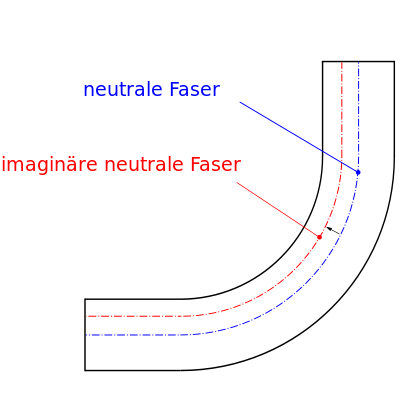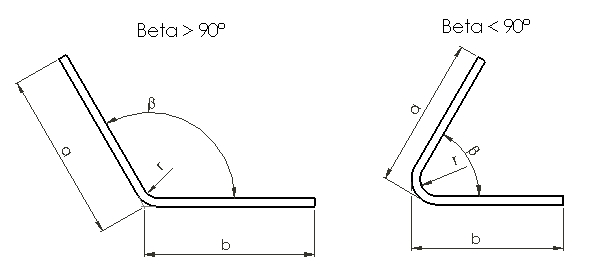Bending shortening
In technical mechanics, bending shortening is the correction deduction for the elongation of a material, which occurs during bending .
When bending, the material is stretched somewhat in the bending zone, i.e. plastically elongated. Therefore, the development for the sheet metal blank (blank) must be shortened before bending. This length correction is the so-called bending shortening.
Influencing parameters for the shortening of the bend
The bending shortening depends on the material (ductility, strength, structure type, grain size), the sheet thickness (ratio of thickness to radius), the position of the bend in relation to the rolling direction, the type of bending (see bending tool, e.g. die bending , free bending , swivel bending ), the surface roughness (sheet metal and tools), the presence of lubricant and coatings, the bending radius and the size of the bending angle (flat = little influence, steep = correction necessary). Even if the above parameters are theoretically known exactly and are included in the calculation of the processing, there will still be deviations in production. This is e.g. B. due to the deviating dimensional accuracy of the sheet metal thickness (thickness tolerance), the fluctuating strength, the manufacturing accuracy of the machine (play, offset errors in the stop and tool travel), etc.
Consideration of the bending shortening
The production of folded sheet metal parts is based on suitably cut blanks so that the finished part with the desired dimensions results after bending. Since the geometry of the finished product is usually determined by design, the required cut, the so-called development, is to be determined from this. In addition to the geometrical correctness (shape and position of the individual surfaces in relation to one another), the so-called bending shortening must be included in the size of the development. The correction and calculation methods used can be illustrated using a simply curved angle.
Processing with neutral fibers at half the sheet metal thickness
Often the stretched length is determined in a simplified manner by assuming the so-called neutral fiber , as shown in Fig. 01 with dashed lines, on half the sheet metal thickness.
The stretched length L results from the sum of the unbent stretches and the arc length in between:
In the practice of folding, however, there is a discrepancy between the stretched lengths determined in this way and the cut lengths actually required for the desired finished dimensions. The reason for this is that the sheet is stretched when it is bent. Because the stretched length usually has to be shorter than it would be according to the above calculation method, it is known as bending shortening .
Correction by the so-called k-factor
By introducing a k-factor (short for correction factor), the determination of the straight lengths is made more precise by shifting the neutral fiber from the center of the sheet.
The k-factor indicates the proportion of the sheet thickness at which the neutral fiber is assumed for the calculation. The smallest possible sensible value shifts the neutral fiber to the inside of the sheet. The standardization specified in DIN 6935 (Note: DIN 6935 was withdrawn without replacement in April 2007 and re-published in 2010.) of the k-factor is identical to the definition in the corresponding ISO standard. According to ANSI, the value range is defined differently, but the concept is identical:
| ISO / DIN | ANSI | |
| Sheet metal inside | 0 | 0 |
| half sheet thickness | 1 | 0.5 |
| Sheet metal outside | 2 | 1 |
Standardized range of values for the k-factor
Extension of the k-factor to the shortening formula
In practice it turns out that a correction with a static k-factor only delivers good results if the opening angles do not vary too much. The measured shortening depends on the angle, but not linearly. The extension of the k-factor by a formula that produces an angle dependency is supported by some software providers, but is not practical.
Tabular correction by means of deduction value
A simple way to achieve good results is to use a table in which empirically determined reduction values are stored and evaluated by the CAD software used. It is noteworthy that in the relevant DIN 6935 standard, the leg lengths are defined differently depending on the opening angle (at 90 ° the values coincide):
In the case of vertex dimensioning (total leg length up to the vertex), a compensation value v is deducted:
The stretched length results as
With
for opening angles between 90 ° and 165 °.
for opening angles from 15 ° to 90 ° and
- β = opening angle
- = Correction factor
- = Bending radius (inner radius)
- = Material thickness
For opening angles greater than 165 °, the bending shortening v becomes negligibly small.
This calculation is based on DIN 6935. It is due to the fact that 90 ° angles are preferably specified with the external dimensions. Basically, the bow is deducted from the leg lengths and a shortened piece is added back. The effect of the shortening of the bend is taken into account by using an arc with a smaller radius instead of the arc segment with the neutral fiber in the middle. The distance of this radius from the inside of the angle is determined by the k-factor.
A general approach for calculating the straight length for all angles between 0 ° and 165 ° is obtained by calculating and adding up the sections separately. Instead of the apex measurements, use the straight ends and the bow section:
- (Alpha in the drawing above is not shown as a bending angle compared to the opening angle beta)
for 90 ° results
With
- α = bending angle (angle by which the sheet is bent out of the plane, α = 180 ° -β)
- = Bending radius (inner radius)
- = Material thickness
The correction factor k is calculated using the following formula
See also
Web links
- Bend shortening_General approach (PDF file; 346 kB)
- Program for calculating the stretched length
Individual evidence
- ^ Table book Metall 44th edition, 2008, ISBN 978-3-8085-1674-4 , p. 319.














